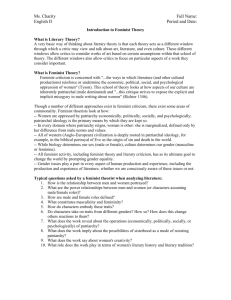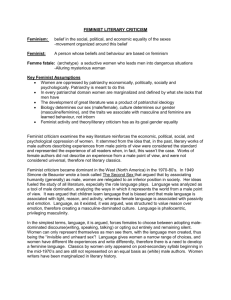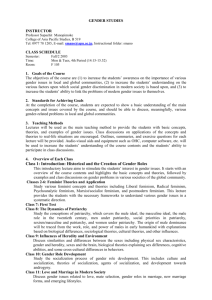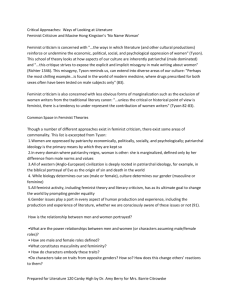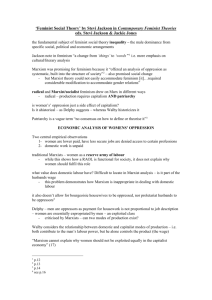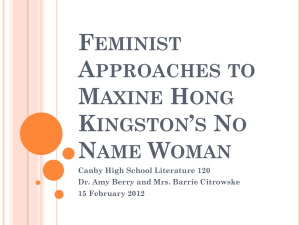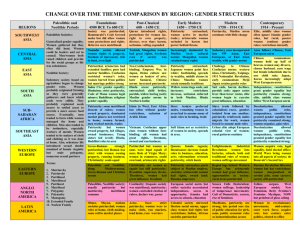Bargaining with Patriarchy Deniz Kandiyoti Gender and Society, Vol
advertisement
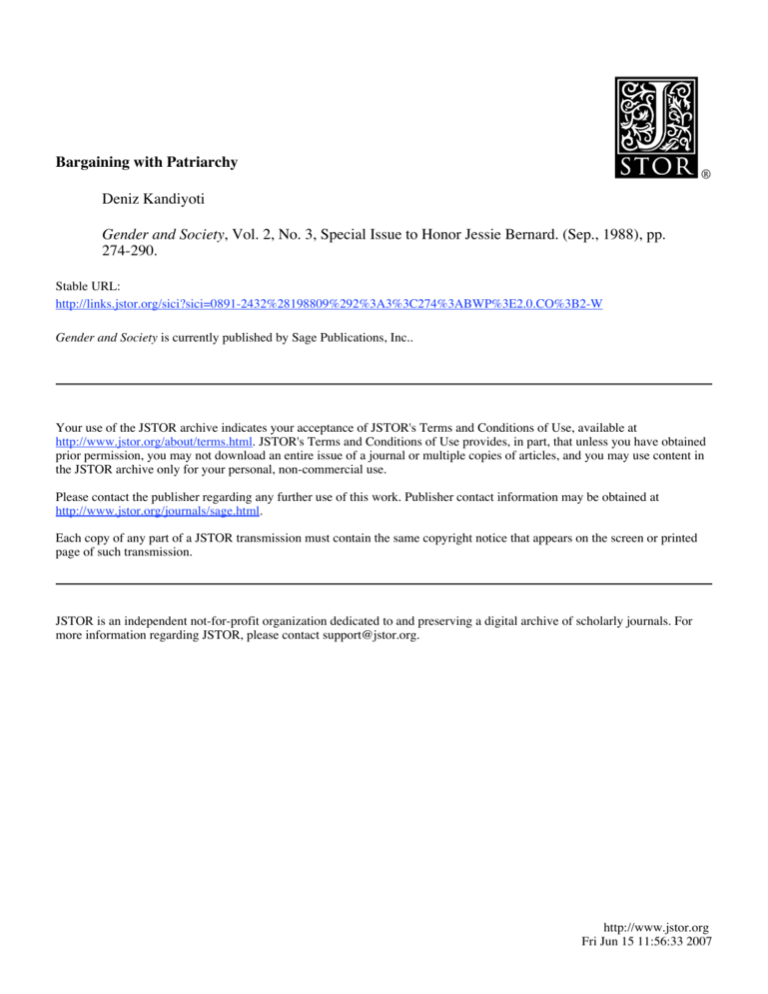
Bargaining with Patriarchy Deniz Kandiyoti Gender and Society, Vol. 2, No. 3, Special Issue to Honor Jessie Bernard. (Sep., 1988), pp. 274-290. Stable URL: http://links.jstor.org/sici?sici=0891-2432%28198809%292%3A3%3C274%3ABWP%3E2.0.CO%3B2-W Gender and Society is currently published by Sage Publications, Inc.. Your use of the JSTOR archive indicates your acceptance of JSTOR's Terms and Conditions of Use, available at http://www.jstor.org/about/terms.html. JSTOR's Terms and Conditions of Use provides, in part, that unless you have obtained prior permission, you may not download an entire issue of a journal or multiple copies of articles, and you may use content in the JSTOR archive only for your personal, non-commercial use. Please contact the publisher regarding any further use of this work. Publisher contact information may be obtained at http://www.jstor.org/journals/sage.html. Each copy of any part of a JSTOR transmission must contain the same copyright notice that appears on the screen or printed page of such transmission. JSTOR is an independent not-for-profit organization dedicated to and preserving a digital archive of scholarly journals. For more information regarding JSTOR, please contact support@jstor.org. http://www.jstor.org Fri Jun 15 11:56:33 2007 BARGAINING W I T H PATRIARCHY DENIZ K A N D I Y O T I Richmond College, United Kingdom T h i s article argues that systematic comparative analyses of women's strategies and coping mechanisms lead to a more culturally and temporally grounded understanding of patriarchal systems than the unqualified, abstract notion of patriarchy encountered in contemporary feminist theory. Women strategize within a set of concreteconstraints, which I identify as patriarchal bargains. Different forms of patriarchy present women with distinct "rules of the game" and call for different strategies to maximize security and optimize life options with varying potentialfor active or passive resistance in the face of oppression. T w o systems of male dominance are contrasted: the sub-Saharan African pattern, in which the insecurities of polygyny are matched with areas of relative autonomy for women, and classicpatriarchy, which is characteristic of South and East Asia as well as the Muslim Middle East. T h e article ends with an analysis of the conditions leading to the breakdown and transformation of patriarchal bargains and their implicationsfor women's consciousness and struggles. Of all the concepts generated by contemporary feminist theory, patriarchy is probably the most overused and, in some respects, the most undertheorized. This state of affairs is not due to neglect, since there is a substantial volume of writing on the question, but rather to the specific conditions of development of contemporary feminist usages of the term. While radical feminists encouraged a very liberal usage, to apply to virtually any form or instance of male domination, socialist feminists have mainly restricted themselves to analyzing the relationships between patriarchy and class under capitalism. As a result, the term patriarchy often evokes an overly monolithic concepAUTHOR'S NOTE: A n earlier version of this article, titled "Deconstructing Patriarchy," was presented at the Eleventh World Congress of Sociology, New Delhi, and at the Center for the Study of Women in Society at the University of Oregon in Eugene. My thanks are due to Joan Acker for her consistent support, to Maxine Molyneux, Bina Agarwal, and Marjorie Mbilinyi for inspiringdiscussionsof the topic, to Judith Stacey for her helpful editorial comments, and to Judith Lorber for her skillful editing. Reprint requests should be sent to Professor Deniz Kandiyoti, 10 Ashmount Road, London N19 3BH, England. GENDER & SOCIETY, Vol. 2 No. 3, September 1988 274-290 Q 1988 Sociologists for Women in Society Kandiyoti / BARGAINING WITH PATRIARCHY 275 tion of male dominance, which is treated at a level of abstraction that obfuscates rather than reveals the intimate inner workings of culturally and historically distinct arrangements between the genders. It is not my intention to provide a review of the theoretical debates around patriarchy (Barrett 1980;Beechey 1979;Delphy 1977;Eisenstein 1978; Hartmann 1981; McDonough and Harrison 1978; Mies 1986; Mitchell 1973; Young 1981). Instead, I would like to propose an important and relatively neglected point of entry for the identification of different forms of patriarchy through an analysis of women's strategies in dealing with them. I will argue that women strategize within a set of concrete constraints that reveal and define the blueprint of what I will term the patriarchal bargain' of any given society, which may exhibit variations according to class, caste, and ethnicity. These patriarchal bargains exert a powerful influence on the shaping of women's gendered subjectivity and determine the nature of gender ideology in different contexts. They also influence both the potential for and specific forms of women's active or passive resistance in the face of their oppression. Moreover, patriarchal bargains are not timeless or immutable entities, but are susceptible to historical transformations that open u p new areas of struggle and renegotiation of the relations between genders. By way of illustration, I will contrast two systems of male dominance, rendered ideal-typical for the purposes of discussing their implications for women. I use these ideal types as heuristic devices that have the potential of being expanded and fleshed out with systematic, comparative, empirical content, although this article makes no pretense at providing anything beyond a mere sketch of possible variations. The two types are based on examples from sub-Saharan Africa, on the one hand, and the Middle East, South Asia, and East Asia on the other. My aim is to highlight a continuum ranging from less corporate forms of householding, involving the relative autonomy of mother-child units evidenced in sub-Saharan polygyny, to the more corporate male-headedentities prevalent in the regions identified by Caldwell(1978)as the "patriarchal belt." In the final section, I analyze the breakdown and transformation of patriarchal bargains and their relationship to women's consciousness and struggles. AUTONOMY AND PROTEST: SOME EXAMPLES FROM SUB-SAHARAN AFRICA I had one of my purest experiences of culture shock in the process of reviewing the literature on women in agricultural development 276 GENDER & SOCIETY / September 1988 projects in sub-Saharan Africa (Kandiyoti 1985).Accustomedas I was to only one type of patriarchy (which I shall describe in some detail later, under the rubric of classic patriarchy), I was ill prepared for what I found. The literature was rife with instances of women's resistance to attempts to lower the value of their labor and, more important, women's refusal to allow the total appropriation of their production by their husbands. Let me give some examples. Wherever new agricultural schemes provided men with inputs and credit, and the assumption was made that as heads of household they would have access to their wives' unremunerated labor, problems seemed to develop. In the Mwea irrigated rice settlement in Kenya, where women were deprived of access to their own plots, their lack of alternatives and their total lack of control over men's earnings made life so intolerable to them that wives commonly deserted their husbands (Hanger and Moris 1973). In Gambia, in yet another ricegrowing scheme, the irrigated land and credit were made available to men only, even though i t was the women who traditionally grew rice in tidal swamps, and there was a long-standing practice of men and women cultivating their own crops and controlling the produce. Women's customary duties with respect to labor allocation to common and individual plots protected them from demands by their husbands that they provide free labor on men's irrigated rice fields. Men had to pay their wives wages or lend them an irrigated plot to have access to their labor. In the rainy season, when women had the alternative of growing their own swamp rice, they created a labor bottleneck for the men, who simply had to wait for the days women did not go to their own fields (Dey 1981). In Conti's (1979) account of a supervised smallholder settlement project in Upper Volta, again, the men were provided with land and credit, leaving the women no independent resource base and a very inadequate infrastructure to carry out their daily household chores. The result was vocal protest and refusal to cooperate. Roberts (forthcoming) similarly illustrates the strategies used by women to maximize their autonomy in the African context. Yoruba women in Nigeria, for instance, negotiate the terms of their farm-labor services to their husbands while they aim to devote more time and energy to the trading activities that will enable them to support themselves and ultimately give u p such services. Hausa women, whose observance of Islamic seclusion reduces the demands husbands can make for their services, allocate their labor to trade, mainly the sale of ready-cooked foodstuffs. Kandiyoti / BARGAINING WITH PATRIARCHY 277 In short, the insecurities of African polygyny for women are matched by areas of relative autonomy that they clearly strive to maximize. Men's responsibility for their wives' support, while normative in some instances, is in actual fact relatively low. Typically, it is the woman who is primarily responsible for her own and her children's upkeep, including meeting the costs of their education, with variable degrees of assistance from her husband. Women have very little to gain and a lot to lose by becoming totally dependent on husbands, and hence they quite rightly resist projects that tilt the delicate balance they s&ive to maintain. In their protests, wives are safeguarding already existing spheres of autonomy. Documentation of a genuine trade-off between women's autonomy and men's responsibility for their wives can be found in some historical examples. Mann (1985) suggests that despite the wifely dependence entailed by Christian marriage, Yoruba women in Lagos accepted it with enthusiasm because of the greater protection they thought they would receive. Conversely, men in contemporary Zambia resist the more modern ordinance marriage, as opposed to customary marriage, because it burdens them with greater obligations for their wives and children (Munachonga 1982).A form of conjugal union in which the partners may openly negotiate the exchange of sexual and labor services seems to lay the groundwork for more explicit forms of bargaining. Commentingon Ashanti marriage, Abu (1983, p. 156)singles out as its most striking feature "the separateness of spouses' resources and activities and the overtness of the bargaining element in the relationship." Polygyny and, in this case, the continuing obligations of both men and women to their own kin do not foster a notion of the family or household as a corporate entity. Clearly, there are important variations in African kinship systems with respect to marriage forms, residence, descent, and inheritance rules (Guyer and Peters 1987). These variations are grounded in complete cultural and historical processes, including different modes of incorporation of African societies into the world economy (Mbilinyi 1982; Murray 1987; S. Young 1977). Nonetheless, it is within a broadly defined Afro-Caribbean pattern that we find some of the clearest instances of noncorporateness of the conjugal family both in ideology and practice, a fact that informs marital and marketplace strategies for women. Works on historical transformations (for example, Etienne and Leacock 1980)suggest that colonization eroded the material basis for women's relative autonomy (such as usufructary access to communal land or traditional craft production) without 278 GENDER & SOCIETY / September 1988 offering attenuating modifications in either marketplace or marital options. The more contemporary development projects discussed above also tend to assume or impose a male-headed corporate family model, which curtails women's options without opening u p other avenues to security and well-being. The women perceive these changes, especially if they occur abruptly, as infractions that constitute a breach of their existing accommodations with the maledominated order. Consequently, they openly resist them. SUBSERVIENCE AND MANIPULATION: WOMEN UNDER CLASSIC PATRIARCHY These examples of women's open resistance stand in stark contrast to women's accommodations to the system I will call classic patriarchy. The clearest instance of classic patriarchy may be found in a geographical area that includes North Africa, the Muslim Middle East (includingTurkey, Pakistan, and Iran), and South and East Asia (specifically, India and China).* T h e key to the reproduction of classic patriarchy lies in the operations of the patrilocally extended household, which is also commonly associated with the reproduction of the peasantry in agrarian societies (E. Wolf 1966). Even though demographic and other constraints may have curtailed the numerical predominance of three-generational patrilocal households, there is little doubt that they represent a powerful cultural ideal. It is plausible that the emergence of the patriarchal extended family, which gives the senior man authority over everyone else, including younger men, is bound u p in the incorporation and control of the family by the state (Ortner 1978), and in the transition from kin-based to tributary modes of surplus control (E. Wolf 1982). The implications of the patrilinealpatrilocal complex for women not only are remarkably uniform but also entail forms of control and subordination that cut across cultural and religious boundaries, such as those of Hinduism, Confucianism, and Islam. Under classic patriarchy, girls are given away in marriage at a very young age into households headed by their husband's father. There, they are subordinate not only to all the men but also to the more senior women, especially their mother-in-law. The extent to which this represents a total break with their own kin group varies in relation to the degree of endogamy in marriage practices and different conceptions of honor. Among the Turks, there are lower rates of Kandiyoti / BARGAINING WITH PATRIARCHY 279 endogamy, and a husband is principally responsible for a woman's honor. Among the Arabs, there is much greater mutuality among affines, and a women's natal family retains both an interest and a say in protecting their married daughter's honor (Meeker 1976). As a result, a Turkish woman's traditional position more closely resembles the status of the "stranger-bride" typical of prerevolutionary China than that of an Arab woman whose position in the patriarchal household may be somewhat attenuated by endogamy and recourse to her natal kin. Whether the prevalent marriage payment is dowry or bride-price, in classic patriarchy, women do not normally have any claim on their father's patrimony. Their dowries do not qualify as a form of premortem inheritance since they are transferred directly to the bridegroom's kin and do not take the form of productive property, such as land (Agarwal 1987; Sharma 1980). In Muslim communities, for a woman to press for her inheritance rights would be tantamount to losing her brothers' favor, her only recourse in case of severe ill-treatment by her husband or divorce. The young bride enters her husband's household as an effectively dispossessed individual who can establish her place in the patriliny only by producing male offspring. The patrilineage totally appropriates both women's labor and progeny and renders their work and contribution to production invisible. Woman's life cycle in the patriarchally extended family is such that the deprivation and hardship she experiences as a young bride is eventually superseded by the control and authority she will have over her own subservient daughters-in-law. T h e cyclical nature of women's power in the household and their anticipation of inheriting the authority of senior women encourages a thorough internalization of this form of patriarchy by the women themselves. In classic patriarchy, subordination to men is offset by the control older women attain over younger women. However, women have access to the only type of labor power they can control, and to old-age security, through their married sons. Since sons are a woman's most critical resource, ensuring their life-long loyalty is an enduring preoccupation. Older women have a vested interest in the suppression of romantic love between youngsters to keep the conjugal bond secondary and to claim sons' primary allegiance. Young women have an interest in circumventing and possibly evading their mother-inlaw's control. There are culturally specific examples of how this struggle works to the detriment of the heterosexual bond (Boudhiba 280 GENDER & SOCIETY / September 1988 1985; Johnson 1983; Mernissi 1975; M. Wolf 1972), but the overall pattern is quite similar. The class or caste impact on classic patriarchy creates additional complications. Among the wealthier strata, the withdrawal of women from nondomestic work is frequently a mark of status institutionalized in various seclusion and exclusion practices, such as the purdah system and veiling. The institution of purdah, and other similar status markers, further reinforces women's subordination and their economic dependence on men. However, the observance of restrictive practices is such a crucial element in the reproduction of family status that women will resist breaking the rules, even if observing them produces economic hardship. They forego economically advantageous options, such as the trading activities engaged in by women in parts of Africa, for alternatives that are perceived as in keeping with their respectable and protected domes tic roles, and so they become more exploitable. In her study of Indian lacemakers in Narsapur, Mies (1982, p. 13) comments: Although domestication of women may be justified by the older forms of seclusion, it has definitely changed its character. T h e Kapu women are no longer gosha-women of a feudal wamor caste-but domesticated housewives and workers who produce for the world market. In the case of the lacemakers this ideology has become almost a material force. The whole system is built on the ideology that these women cannot work outside the house. Thus, unlike women in sub-Saharan Africa who attempt to resist unfavorable labor relations in the household, women in areas of classic patriarchy often adhere as far and as long as they possibly can to rules that result in the unfailing devaluation of their labor. T h e cyclical fluctuations of their power position, combined with status considerations, result in their active collusion in the reproduction of their own subordination. They would rather adopt interpersonal strategies that maximize their security through manipulation of the affections of their sons and husband. As M. Wolf's (1972) insightful discussion of the Chinese uterine family suggests, this strategy can even result in the aging male patriarch losing power to his wife. Even though these individual power tactics do little to alter the structurally unfavorable terms of the overall patriarchal script, women become experts in maximizing their own life chances. Commenting on "female conservatism" in China, Johnson (1983, p. 21) remarks: "Ironically, women through their actions to resist passivity and total male control, became participants with vested Kandiyoti / BARGAINING WITH PATRIARCHY 281 interests in the system that oppressed them." M. Wolf (1974) comments similarly on Chinese women's resistance to the 1950 Marriage Law, of which they were supposed to be the primary beneficiaries. She concludes, however, that despite their reluctance to totally transform the old family system, Chinese women will no longer be content with the limited security their manipulation of family relationships can provide. In other areas of classic patriarchy, changes in material conditions have seriously undermined the normative order. As expressed succinctly by Cain et al. (1979, p. 410), the key to and the irony of this system reside in the fact that "male authority has a material base, while male responsibility is normatively controlled." Their study of a village in Bangladesh offers an excellent example of the strains placed by poverty on bonds of obligation between kin and, more specifically, on men's fulfillment of their normative obligations toward women. Almost a third of the widows in the villages were the heads of their own households, struggling to make a living through waged work. However, the labor-market segmentation created and bolstered by patriarchy meant that their options for work were extremely restricted, and they had to accept very low and uncertain wages. Paradoxically, the risks and uncertainties that women are exposed to in classic patriarchy create a powerful incentive for higher fertility, which under conditions of deepening poverty will almost certainly fail to provide them with an economic shelter. Greeley (1983) also documents the growing dependence of landless households in Bangladesh on women's wage labor, including that of married women, and discusses the ways in which the stability of the patriarchal family is thereby undermined. Stacey's (1983)discussion of the crisis in the Chinese family before the revolution constitutes a classic account of the erosion of the material and ideological foundations of the traditional system. She goes on to explore how Confucian patriarchy was superseded by and transformed into new democratic and socialist forms. In the next section, I will analyze some of the implications of such processes of transformation. THE DEMISE OF PATRIARCHAL BARGAINS: RETREAT INTO CONSERVATISM OR RADICAL PROTEST? The material bases of classic patriarchy crumble under the impact of new market forces, capital penetration in rural areas (Kandiyoti 1984),or processes of chronic immiseration. While there is no single 282 GENDER & SOCIETY / September 1988 path leading to the breakdown of this system, its consequences are fairly uniform. T h e domination of younger men by older men and the shelter of women in the domestic sphere were the hallmarks of a system in which men controlledsome form of viable joint patrimony in land, animals, or commercial capital. Among the propertyless and the dispossessed, the necessity of every household member's contribution to survival turns men's economic protection of women into a myth. T h e breakdown of classic patriarchy results in the earlier emancipation of younger men from their fathers and their earlier separation from the paternal household. While this process implies that women escape the control of mothers-in-law and head their own households at a much younger age, it also means that they themselves can no longer look forward to a future surrounded by subservient daughtersin-law. For the generation of women caught in between, this transformation may represent genuine personal tragedy, since they have paid the heavy price of a n earlier patriarchal bargain, but are not able to cash in on its promised benefits. M. Wolf's (1975) statistics on suicide among women in China suggest a clear change in the trend since the 1930s, with a sharp increase in the suicide rates of women who are over 45, whereas previously the rates were highest among young women, especially new brides. She relates this change explicitly to the emancipation of sons and their new possibility of escaping familial control in the choice of their spouse, which robs the older woman of her power and respectability as mother-in-law. Despite the obstacles that classic patriarchy puts in women's way, which may far outweigh any actual economic and emotional security, women often resist the process of transition because they see the old normative order slipping away from them without any empowering alternatives. In a broader discussion of women's interest, Molyneux (1985, p. 234) remarks: This is not just because of "false consciousness" as is frequently supposed-although this can be a factor-but because such changes realized in a piecemeal fashion could threaten the short-term practical interests of some women, or entail a cost i n the loss of forms of protection that are not then compensated for in some way. Thus, when classic patriarchy enters a crisis, many women may continue to use all the pressure they can muster to make men live u p to their obligations and will not, except under the most extreme pressure, compromise the basis for their claims by stepping out of line Kandiyoti / BARGAINING WITH PATRIARCHY 283 and losing their respectability. Their passive resistance takes the form of claiming their half of this particular patriarchal bargainprotection in exchange for submissiveness and propriety. The response of many women who have to work for wages in this context may be an intensification of traditional modesty markers, such as veiling. Often, through no choice of their own, they are working outside their home and are thus "exposed"; they must now use every symbolic means at their disposal to signify that they continue to be worthy of protection. It is significant that Khomeini's exhortations to keep women at home found enthusiastic support among many Iranian women despite the obvious elements of repression. The implicit promise of increased male responsibility restores the integrity of their original patriarchal bargain in an environment where the range of options available to women is extremely restricted. Younger women adopt the veil, Azari (1983, p. 68) suggests, because "the restriction imposed on them by an Islamic order was therefore a small price that had to be paid in exchange for the security, stability and presumed respect this order promised them. " This analysis of female conservatism as a reaction to the breakdown of classic patriarchy does not by any means exhaust the range of possible responses available to women. It is merely intended to demonstrate the place of a particular strategy within the internal logic of a given system, parallels to which may be found in very different contexts, such as the industrialized societies of Western Europe and the United States. Historical and contemporary analyses of the transformation of the facts and ideologies of Western domesticity imply changes in patriarchal bargains. Gordon's (1982) study of changing feminist attitudes to birth control in the nineteenth and twentieth centuries describes the strategy of voluntary motherhood as part of a broader calculus to improve women's situation. Cott's (1978) analysis of the ideology of passionlessness among Victorian women also indicates the strategic nature of women's choices. For the modern era, Ehrenreich (1983) provides an analysis of the breakdown of the white middle-class patriarchal bargain in the United States. She traces the progressive opting out of men from the breadwinner role starting in the 1950s, and suggests that women's demands for greater autonomy came at a time when men's conjugal responsibility was already much diminished and alternatives for men outside the conjugal union had gained considerable cultural legitimacy. Despite intense ideological mobilization, involving experts 284 GENDER & SOCIETY / September 1988 such as doctors, counselors, and psychologists who tried to reinforce the idea of the responsible male breadwinner and the domesticated housewife, alternative trends started to emerge and to challenge the dominant normative order. Against this background, Ehrenreich evaluates the feminist and the antifeminist movements and says, "It is as if, facing the age-old insecurity of the family wage system, women chose opposite strategies: either to get out (figuratively speaking) and fight for equality of income and opportunity, or to stay home and attempt to bind men more tightly to them" (1983, p. 151). T h e familism of the antifeminist movement could therefore be interpreted as an attempt to reinstate a n older patriarchal bargain, with feminists providing a convenient scapegoat on whom to blame current disaffection and alienation among men (Chafetz and Dworkin 1987). Indeed, Stacey (1987, p. 11) suggests that "feminism serves as a symbolic lightning rod for the widespread nostalgia and longing for lost intimacy and security that presently pervade social and political culture in the United States." However, the forms of consciousness and struggle that emerge in times of rapid social change require sympathetic and open-minded examination, rather than hasty categorization. Thus Ginsburg (1984) evaluates antiabortion activism among women in the United States as strategic rather than necessarily reactionary. She points out that disengaging sexuality from reproduction and domesticity is perceived by many women as inimical to their best interests, since, among other things, it weakens the social pressureon men to take responsibility for the reproductive consequences of sexual activity. This concern and the general anxiety it expresses are by no means unfounded (English 1984) and speak to the current lack of viable alternatives for the emotional and material support of women with children. Similarly, Stacey (1987)identifies diverse forms of "postfeminist" consciousness of the postindustrial era. She suggests that a complex and often contradictory merging of depoliticized feminist attitudes to work and family and of personal strategies to enhance stability and intimacy in marriage are currently taking place. At the ideological level, broken bargains seem to instigate a search for culprits, a hankering for the certainties of a more traditional order, or a more diffuse feeling that change might have gone either too far or badly wrong. Rosenfelt and Stacey's (1987) reflections on postfeminism and Stacey's (1986) discussion of conservative profamily feminism, although they criticize the alarmist premises of neoconservative discourse, take some of the legitimate concerns it expresses seriously. Kandiyoti / BARGAINING WITH PATRIARCHY 285 CONCLUSION Systematic analyses of women's strategies and coping mechanisms can help to capture the nature of patriarchal systems in their cultural, class-specific, and temporal concreteness and reveal how men and women resist, accommodate, adapt, and conflict with each other over resources, rights, and responsibilities. Such analyses dissolve some of the artificial divisions apparent in theoretical discussions of the relationships among class, race, and gender, since participants' strategies are shaped by several levels of constraints. Women's strategies are always played out in the context of identifiable patriarchal bargains that act as implicit scripts that define, limit, and inflect their market and domestic options. The two ideal-typical systems of male dominance discussed in this article provide different baselines from which women negotiate and strategize, and each affects the forms and potentialities of their resistance and struggles. Patriarchal bargains do not merely inform women's rational choices but also shape the more unconscious aspects of their gendered subjectivity, since they permeate the context of their early socialization, as well as their adult cultural milieu (Kandiyoti 1987a, 1987b). A focus on more narrowly defined patriarchal bargains, rather than on an unqualified notion of patriarchy, offers better prospects for the detailed analysis of processes of transformation. In her analysis of changes in sexual imagery and mores in Western societies, Janeway (1980) borrows Thomas Kuhn's (1970) terminology of scientific paradigms. She suggests, by analogy, that widely shared ideas and practices in the realm of sexuality may act as sexual paradigms, establishing the rules of normalcy at any given time, but also vulnerable to change when "existing rules fail to operate, when anomalies can no longer be evaded, when the real world of everyday experience challenges accepted causality" (1980, p. 582). However, sexual paradigms cannot be fully comprehended unless they are inscribed in the rules of more specifically defined patriarchal bargains, as Janeway herself demonstrates in her discussion of the connection between the ideal of female chastity in Western societies and the transmission of property to legitimate heirs before the advent of a generalized cash economy. T o stretch the Kuhnian analogy even further, patriarchal bargains can be shown to have a normal phase and a crisis phase, a concept that modifies our very interpretation of what is going on in the world. Thus, during the normal phase of classic patriarchy, there were large numbers of women who were in fact exposed to economic hardship 286 GENDER & SOCIETY / September 1988 and insecurity. They were infertile and had to be divorced, or orphaned and without recourse to their own natal family, or unprotected because they had no surviving sons or-even worse-had "ungrateful" sons. However, they were merely considered "unlucky," anomalies and accidental casualties of a system that made sense otherwise. It is only at the point of breakdown that every order reveals its systemic contradictions. The impact of contemporary socioeconomic transformations upon mamage and divorce, on household formation, and on the gendered division of labor inevitably lead to a questioning of the fundamental, implicit assumptions behindarrangements between women and men. However, new strategies and forms of consciousness do not simply emerge from the ruins of the old and smoothly produce a new consensus, but are created through personal and political struggles, which are often complex and contradictory (see Strathern 1987).The breakdown of a particular patriarchal system may, in the short run, generate instances of passive resistance among women that take the paradoxical form of bids for increased responsibility and control by men. A better understanding of the short- and medium-term strategies of women in different social locations could provide a corrective influence to ethnocentric or class-bound definitions of what constitutes a feminist consciousness. NOTES 1. Like all terms coined to convey a complex concept, the term patriarchal bargain represents a difficult compromise. It is intended to indicate the existence of set rules and scripts regulating gender relations, to which both genders accommodate and acquiesce, yet which may nonetheless be contested, redefined, and renegotiated. Some suggested alternatives were the terms contract, deal, or scenario; however, none of these fully captured the fluidity and tension implied by bargain. I am grateful to Cynthia Cockburn and Nels Johnson for pointingout that the term bargain commonly denotes a deal between more or less equal participants, so it does not accurately apply to my usage, which clearly indicates an asymmetrical exchange. However, women as a rule bargain from a weaker position. 2. I am excluding not only Southeast Asia but also the Northern Mediterranean, despite important similarities in the latter regarding codes of honor and the overall importance attached to the sexual purity of women, because I want to restrict myself to areas where the patrilocal-patrilineal complex is dominant. T h u s societies with bilateral kinship systems, such as Greece, in which women d o inherit and control property and receive dowries that constitute productive property, do not qualify despite important similarities in other ideological respects. This is not, however, to Kandiyoti / BARGAINING WITH PATRIARCHY 287 suggest that an unqualified homogeneity of ideology and practice exists within the geographical boundaries indicated. For example, there are critical variations within the Indian subcontinent that have demonstrably different implications for women (Dyson and Moore 1983). Conversely, even in areas of bilateral kinship, there may be instances in which all the facets of classic patriarchy, namely, property, residence, and descent through the male line, may coalesce under specified circumstances (Denich 1974).What I am suggestingis that the most clear-cut and easily identifiableexamples of classic patriarchy may be found within the boundaries indicated in the text REFERENCES Abu, K. 1983. "The Separateness of Spouses: Conjugal Resources in an Ashanti Town." Pp. 156-68 in Female and Male in West Africa, edited by C. Oppong. London: George Allen & Unwin. Aganual, B. 1987. "Women and Land Rights in India." Unpublished manuscript. Azari, F. 1983. "Islam's Appeal to Women in Iran: Illusion and Reality." Pp. 1-71 in Women of Iran: The Conflict with Fundamentalist Islam, edited by F. Azari. London: Ithaca Press. Barrett, M. 1980. Woman's Oppression Today. London: Verso. Beechey, V. 1979. "On Patriarchy." Feminist Review 3:66-82. Boudhiba, A. 1985. Sexuality in Islam. London: Routledge & Kegan Paul. Cain, M., S. R. Khanan, and S. Nahar. 1979. "Class, Patriarchy, and Women's Work in Bangladesh." Population and Development Review 5:408-16. Caldwell, J. C. 1978. "A Theory of Fertility: From High Plateau to Destabilization." Population and Development Review 4:553-77. Chafetz, J. S. and A. G. Dworkin. 1987. "In Faceof Threat: Organized Antifeminism in Comparative Perspective." Gender & Society 1%-60. Conti, A. 1979. "Capitalist Organization of Production Through Non-capitalist Relations: Women's Role in a Pilot Resettlement Project in Upper Volta." Review of African Political Economy 15/16:75-91. Cott, N. F. 1978. "Passionlessness: An Interpretation of Victorian Sexual Ideology, 1790-1850." Signs:]ournal of Women in Culture and Society 4:219-36. Delphy, C. 1977. The Main Enemy. London: Women's Research and Resource Centre. Denich, B. S. 1974. "Sexand Power in the Balkans." Pp. 243-62 in Women, Cultureand Society, edited by M. 2. Rosaldo and L. Lamphere. Palo Alto, CA: Stanford University Press. Dey, J. 1981. "Gambian Women: Unequal Partners in Rice Development Projects." Pp. 109-22 in African Women in the Development Process, edited by N. Nelson. London: Frank Cass. Dyson, T . and M. Moore. 1983. "On Kinship Structures, Female Autonomy and Demographic Behavior." Population and Development Review 935-60. Ehrenreich, B. 1983. The Hearfs of Men. London: Pluto Press. Eisenstein, 2. 1978. "Developing a Theory of Capitalist Patriarchy and Socialist Feminism." Pp. 5-40 in Capitalist Patriarchy and the Case for Socialist Feminism, edited by 2. Eisenstein. New York: Monthly Review Press. 288 GENDER & SOCIETY / September 1988 English, D. 1984. "The Fear That Feminism Will Free Men First." Pp. 97-102 in Powers of Desire: T h e Politics of Sexuality, edited by A. Snitow, C. Stansell, and S. Thompson. New York: Monthly Review Press. Etienne, M. and E. Leacock(eds.). 1980. Womenand Colonization. New York: Praeger. Ginsburg, F. 1984. "The Body Politic: T h e Defense of Sexual Restriction by AntiAbortion Activists." Pp. 173-88 in Pleasure and Danger: Exploring Female Sexuality, edited by C. S. Vance. London: Routledge & Kegan Paul. Gordon, L. 1982. "Why Nineteenth Century Feminists Did Not Support (Birth Control) and Twentieth Century Feminists Do: Feminism, Reproduction and the Family." Pp. 40-53 in Rethinking the Family: Some Feminist Questions, edited by B. Thome and M. Yalom. New York: Longman. Greeley, M. 1983. "Patriarchy and Poverty: A Bangladesh Case Study." South Asia Research 335-55. Guyer, J. I. and P. E. Peters. 1987. "'Introduction' to Conceptualizing the Household: Issues of Theory and Policy in Africa." Development and Change 18:197-213. Hanger, J. and J. Moris. 1973. "Women and the Household Economy." Pp. 209-44 in Mwea:An Irrigated Rice Settlement i n Kenya, edited by R. Chambers and J. Moris. Munich: Weltforum Verlag. Hartmann. H. 1981. "The Unhappy Marriage of Marxism and Feminism: Towards a More Progressive Union." Pp. 40-53 in Women and Reuolution, edited by L. Sargent. London: Pluto Press. Janeway, E. 1980. "Who Is Sylvia? On the Loss of Sexual Paradigms." Signs:]ournal of Women in Culture and Society 5:573-89. Johnson, K. A. 1983. Women, the Family and Peasant Revolution in China. Chicago: Chicago University Press. Kandiyoti, D. 1984. "Rural Transformation in Turkey and Its Implications for Women's Studies." Pp. 17-29 in Women on the Move: Contemporary Transformations in Family and Society. Paris: UNESCO. ---. 1985. W o m e n in Rural Production Systems: Problems and Policies. Paris: UNESCO. . 1987a. "Emancipated but Unliberated? Reflections on the Turkish Case." Feminist Studies 13317-38. . 1987b. "The Problem of Subjectivity in Western Feminist Theory." Paper presented at the American Sociological Association Annual Meeting, Chicago. Kuhn, T . 1970. T h e structure of Scientific Reuolutions (2nd ed.). Chicago: Chicago University Press. Mann, K. 1985. Marrying Well: Marriage, Status and Social Change Among the Educated Elite in Colonial Lagos. Cambridge: Cambridge University Press. Mbilinyi, M. J. 1982. "Wife, Slave and Subject of the King: The Oppressionof Women in the Shambala Kingdom." Tanzania Notes and Records 88/89:1-13. McDonough, R. and R. Harrison. 1978. "Patriarchy and Relations of Production." Pp. 11-41in Feminism and Materialism, edited by A. Kuhn and A. M. Wolpe. London: Routledge & Kegan Paul. Meeker, M. 1976. "Meaning and Society in the Near East: Examples from the Black Sea Turks and the Levantine Arabs." International Journal of Middle East Studies 7:383-422. Mernissi, F. 1975. Beyond the Veil: Male-Female Dynamics in a Muslim Society. New York: Wiley. --A --A Kandiyoti / BARGAINING WITH PATRIARCHY 289 Mies, M. 1982. "The Dynamics of Sexual Division of Labour and the Integration of Women into the World Market." Pp. 1-28in Women and Development: Thesexual Division of Labour in Rural Societies, edited by L. Beneria. New York: Praeger. ---. 1986. Patriarchy and Accumulation on a World Scale: Women in the International Division of Labour. London: Zed. Mitchell, J. 1973. Women's Estate. New York: Vintage. . 1986. "Reflections on Twenty Years of Feminism." Pp. 34-48 in What is Feminism? edited by J . Mitchell and A. Oakley. Oxford: Basil Blackwell. Molyneux, M. 1985. "Mobilization Without Emancipation? Women's Interests, the State and Revolution in Nicaragua." Feminist Studies 11:227-54. Munachonga, M. L. 1982. "Income Allocation and Mamage Options in Urban Zambia: Wives Versus Extended Kin." Paper presented at the Conference on Women and Income Control in the Third World, New York. Murray, C. 1987. "Class, Gender and the Household: The Developmental Cycle in Southern Africa." Development and Change 18:235-50. Ortner, S. 1978. "The Virgin and the State." Feminist Studies 4:19-36. Roberts, P. Forthcoming. "Rural Women in Western Nigeria and Hausa Niger: A Comparative Analysis," in Seruing T w o Masters, edited by K. Young. New Delhi: Allied Publishers. Rosenfelt, D. and J. Stacey. 1987. "SecondThoughts on the Second Wave." Feminist Studies 13341-61. Sharma, U. 1980. Women, Work and Property in North West India. London: Tavistock. Stacey, J. 1983.Patriarchy and Socialist Revolution in China. Berkeley: University of California Press. ---. 1986. "Are Feminists Afraid to Leave Home? The Challenge of Conservative Pro-Family Feminism." Pp. 219-48 in What is Feminism?edited by J . Mitchell and A. Oakley. Oxford: Basil Blackwell. ---. 1987. "Sexism by a Subtler Name? Postindustrial Conditionsand Postfeminist Consciousness in the Silicon Valley." Socialist Review (Nov.):7-28. Strathern, M. 1987. "An Awkward Relationship: The Case of Feminism and Anthropology." Signs:]oumal of Women in Culture and Society 12:276-92. Wolf, E. 1966. Peasants. Englewood Cliffs, NJ: Prentice-Hall. ---. 1982. Europe and the People Without History. Berkeley: University of California Press. Wolf, M. 1972. Women and the Family in Rural Taiwan. Palo Alto, CA: Stanford University Press. ---. 1974. "Chinese Women: Old Skills in a New Context." Pp. 157-72 in Women, Culture and Society, edited by M. 2. Rosaldo and L. Lamphere. Palo Alto, CA: Stanford University Press. ---. 1975. "Woman and Suicide in China.'' Pp. 111-41 in Women in Chinese Society, edited by M. Wolf and R. Witke. Palo Alto, CA: Stanford University Press. Young, I. 1981. "Beyond the Unhappy Marriage: A Critique of the Dual Systems Theory." Pp. 43-69 in Women and Revolution, edited by L. Sargent. London: Pluto Press. Young, S. 1977. "Fertility and Famine: Women's Agricultural History in Southern Mozambique." Pp. 66-81 in The Roots of Rural P o v ~ t yin Central and Southern Africa, d t e d by R. Palmer and N. Parsons. London: Heinemann. --A 290 GENDER & SOCIETY / September 1988 Deniz Kandiyoti, Senior Lecturer in the Social Sciences Division, Richmond College, Surrey, England, taught and did research in Turkey from 1969 to 1980. Her research and publicatzons are in the fields of women and development, women in the Middle East, and feminist theory. http://www.jstor.org LINKED CITATIONS - Page 1 of 3 - You have printed the following article: Bargaining with Patriarchy Deniz Kandiyoti Gender and Society, Vol. 2, No. 3, Special Issue to Honor Jessie Bernard. (Sep., 1988), pp. 274-290. Stable URL: http://links.jstor.org/sici?sici=0891-2432%28198809%292%3A3%3C274%3ABWP%3E2.0.CO%3B2-W This article references the following linked citations. If you are trying to access articles from an off-campus location, you may be required to first logon via your library web site to access JSTOR. Please visit your library's website or contact a librarian to learn about options for remote access to JSTOR. Notes 2 On Kinship Structure, Female Autonomy, and Demographic Behavior in India Tim Dyson; Mick Moore Population and Development Review, Vol. 9, No. 1. (Mar., 1983), pp. 35-60. Stable URL: http://links.jstor.org/sici?sici=0098-7921%28198303%299%3A1%3C35%3AOKSFAA%3E2.0.CO%3B2-U References On Patriarchy Veronica Beechey Feminist Review, No. 3. (1979), pp. 66-82. Stable URL: http://links.jstor.org/sici?sici=0141-7789%281979%290%3A3%3C66%3AOP%3E2.0.CO%3B2-J Class, Patriarchy, and Women's Work in Bangladesh Mead Cain; Syeda Rokeya Khanam; Shamsun Nahar Population and Development Review, Vol. 5, No. 3. (Sep., 1979), pp. 405-438. Stable URL: http://links.jstor.org/sici?sici=0098-7921%28197909%295%3A3%3C405%3ACPAWWI%3E2.0.CO%3B2-H NOTE: The reference numbering from the original has been maintained in this citation list. http://www.jstor.org LINKED CITATIONS - Page 2 of 3 - A Theory of Fertility: From High Plateau to Destabilization John C. Caldwell Population and Development Review, Vol. 4, No. 4. (Dec., 1978), pp. 553-577. Stable URL: http://links.jstor.org/sici?sici=0098-7921%28197812%294%3A4%3C553%3AATOFFH%3E2.0.CO%3B2-I On Kinship Structure, Female Autonomy, and Demographic Behavior in India Tim Dyson; Mick Moore Population and Development Review, Vol. 9, No. 1. (Mar., 1983), pp. 35-60. Stable URL: http://links.jstor.org/sici?sici=0098-7921%28198303%299%3A1%3C35%3AOKSFAA%3E2.0.CO%3B2-U Emancipated but Unliberated? Reflections on the Turkish Case Deniz A. Kandiyoti; Deniz Kandiyoti Feminist Studies, Vol. 13, No. 2. (Summer, 1987), pp. 317-338. Stable URL: http://links.jstor.org/sici?sici=0046-3663%28198722%2913%3A2%3C317%3AEBUROT%3E2.0.CO%3B2-N Meaning and Society in the near East: Examples from the Black Sea Turks and the Levantine Arabs (II) Michael E. Meeker International Journal of Middle East Studies, Vol. 7, No. 3. (Jul., 1976), pp. 383-422. Stable URL: http://links.jstor.org/sici?sici=0020-7438%28197607%297%3A3%3C383%3AMASITN%3E2.0.CO%3B2-V Mobilization without Emancipation? Women's Interests, the State, and Revolution in Nicaragua Maxine Molyneux Feminist Studies, Vol. 11, No. 2. (Summer, 1985), pp. 227-254. Stable URL: http://links.jstor.org/sici?sici=0046-3663%28198522%2911%3A2%3C227%3AMWEWIT%3E2.0.CO%3B2-2 The Virgin and the State Sherry B. Ortner Feminist Studies, Vol. 4, No. 3. (Oct., 1978), pp. 19-35. Stable URL: http://links.jstor.org/sici?sici=0046-3663%28197810%294%3A3%3C19%3ATVATS%3E2.0.CO%3B2-5 NOTE: The reference numbering from the original has been maintained in this citation list. http://www.jstor.org LINKED CITATIONS - Page 3 of 3 - Review: Second Thoughts on the Second Wave Reviewed Work(s): Too Late for Prince Charming A Lesser Life: The Myth of Women's Liberation in America by Sylvia Hewlett The Good Mother by Sue Miller Deborah Rosenfelt; Judith Stacey Feminist Studies, Vol. 13, No. 2. (Summer, 1987), pp. 341-361. Stable URL: http://links.jstor.org/sici?sici=0046-3663%28198722%2913%3A2%3C341%3ASTOTSW%3E2.0.CO%3B2-D NOTE: The reference numbering from the original has been maintained in this citation list.

